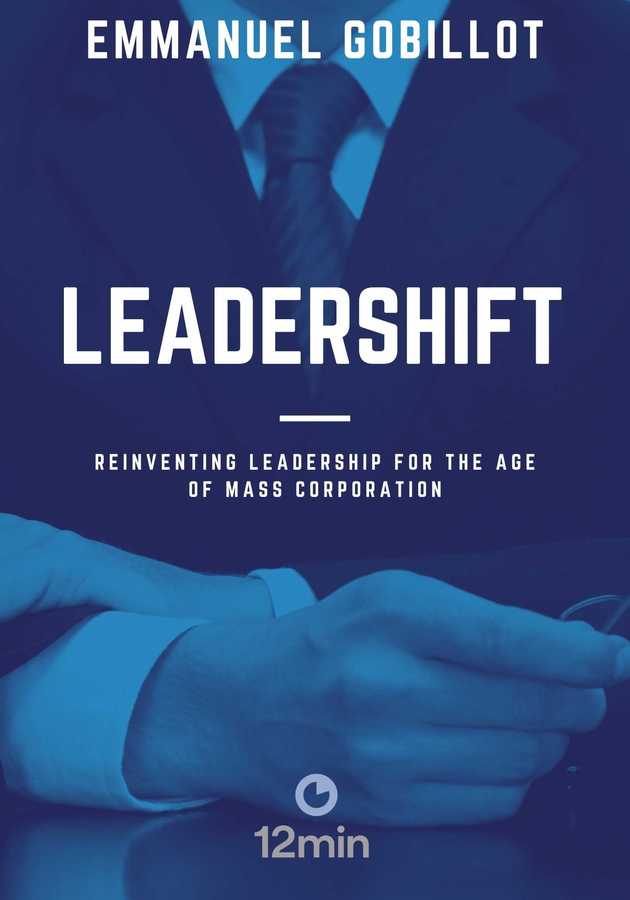Published soon after the financial crisis of 2008, “LeaderShift” by Emmanuel Gobillot explores the changing role of the leader in the age of mass collaboration and horizontal hierarchical structures. Claiming the business world is in the midst of an unprecedented paradigm shift, Gobillot believes that “we are unlikely to get insights into becoming leaders in the next generation by looking back at our experiences or our elders.” So, suitably, he looks forward: after analyzing the four factors which are currently redefining the role of the leader, he speculates on the four adjustments leaders will be required to make to keep up with the times. Essentially, this makes “LeaderShift” a symmetrically structured exploration of four ongoing leadership trends and four related behavioral modifications. Get ready to hear all about them!
The day of reckoning: new leaders are required
Not long before he tragically died at the early age of 44, French writer Antoine de Saint-Exupéry, best known as the author of “The Little Prince,” wrote the following memorable remark: “As for the future, your task is not to foresee it, but to enable it.” Indeed, comments Gobillot, “Our role as leaders is to decide what we want this future to be. Our role is to view our organizations through the lens of 48 million avatars currently roaming the web, 10% of whom do so for more than 10 hours a day. Our role is to decide how we can capture the energy of mass collaboration to redefine first our business models and ultimately the very meaning of business.”
In other words, according to Gobillot, the future is already here but people – and especially leaders and managers – are refusing to accept this simple fact, as the future doesn’t seem to fit their expectations. Contrary to what Adam Smith and his evangelists supposed, it is actually from the benevolence of many people – and not their regard to their own interest – that we’ve been blessed with some of the best things in life. At this very moment, while you’re reading this sentence, millions of people in the world are mass collaborating on numerous grand projects for free, and to make matters more interesting they often do it anonymously.
Just think of Wikipedia. It is the most comprehensive and, possibly, the very best encyclopedia in human history, but it has been mostly written by anonymous contributors, sharing nothing between them but a desire to “lend a hand.” Even though writing in the midst of the financial crisis of 2008, Gobillot is far-sighted enough to call the collapse of the market a “minor turbulence,” not even comparable to the second type of turbulence that’s shaking the world of business – the one triggered by the advancements in technology and the advent of the participatory web. “Whilst the first type of turbulence questions our effectiveness as leaders,” Gobillot writes, “the second kind questions the very essence of leadership.” Let’s see how.
The demographic trend: making your experience irrelevant
As each day passes, “the way leaders create value becomes less effective.” That’s not because leaders are not trying, but because the very levers they pull to be successful – experience, knowledge, effort, and power – are continually being eroded by the four fundamental trends that make up mass collaboration. Gobillot calls these trends the Demographic, Expertise, Attention, and Democratic trend. Together these four trends spell the death of leadership as we know it. Not just metaphorically, but quite literally: if you take their initials, they form the acronym DEAD. That’s why Gobillot refers to them, collectively, as the DEAD trends.
As we already noted, the first of these trends is the demographic trend. As explained by Gobillot, the demographic trend is all about how we find ourselves today working alongside multiple generations with multiple sociocultural backgrounds. The workplace, in other words, is more diverse than ever, and in every imaginable way. The problem with this – if you could call it that – is that diversity tends to breed confusion and, even worse, miscommunication. After all, when each worker brings with them their own hopes, fears, expectations and experiences – and when behind all of them there’s a deep history others know little about – colleagues cannot easily understand each other, since they usually share no common pool of meaning. This should obviously affect leaders. But how?
Well, first of all, leaders must know that they are in charge of people with vastly different backgrounds and experiences than theirs. They should also be aware that long gone are the days of the assembly-line-based Victorian style of education, not to mention the days of the overtly racist and covertly sexist work environment. Nowadays, leaders must learn how to simultaneously get along with, say, a 52-year-old blue-collar American manager, a 32-year-old female African-American graphic designer, and a 23-year-old Mexican intern with a unique expertise. No personal experience of any kind – no matter how wide-ranging – could help the leaders of today empathize with all of their workers, let alone guide them to growth and success. In a word, experience – one of the four pillars of leadership – has become all but irrelevant.
The expertise trend: making your knowledge irrelevant
Think of Wikipedia once again. Though very few of the people who have contributed to its creation are deemed experts in their fields, even the foremost experts of today – in any field – tend to consult Wikipedia during their research. Why shouldn’t they? There’s absolutely everything there, from a comprehensive bibliography of Thomas Mann’s works to every single Academy Award nominee in every category that has ever existed to the latest and most current advancements in quantum physics. There’s also something you will never find anywhere else, say, a list of all articles that are themselves lists of article lists. That is to say, a list of lists of lists.
Now, that’s the power of the participative web, or Web 2.0, for short. Ever since the very beginning of the 21st century, this is the name which (according to Wikipedia, of course) journalists use to refer to “websites that emphasize user-generated content, ease of use, participatory culture and interoperability for end-users.” As of today, whilst traditional websites are growing by about 20% a year, user-generated media sites are growing at about 100% a year. In the words of Gobillot, “The drive for co-creation illustrated by user-generated content seems relentless.” Wikipedia is just the most quoted example, but far from it being the only one. Think of blogs or podcasts, think of free dictionaries and the Open Street Map. Think, finally, of YouTube and Facebook themselves.
Until very recently, many companies and organizations existed because it was pretty much impossible for a company to manage such large projects. However, now that technology has allowed for networks of ordinary people “to create value in a much more inclusive, and therefore powerful way,” these organizations have grown quite obsolete. Put in plainer words, if an entire encyclopedia can be composed without a single expert, and if billions of YouTube tutorials and Massive Open Online Courses (MOOCs) are available for everybody for free, then what are really experts for? “The expertise that drives organizational value now resides in a network of relationships outside the managerial reach of the organization itself,” writes Gobillot. “This raises questions about the very value of organizations and, by association, their leaders.”
The attention trend: making your efforts irrelevant
The third trend that has been slowly eroding the traditional leadership role is the attention trend. As it has never before been the case, nowadays we pay attention to only a small part of what is happening around us – and we wouldn’t have been able to pay attention to everything even if we desperately wanted to. As a result, it’s pretty much irrelevant how much leaders try to do their best – a lot of their work simply goes unnoticed. Having troubles comprehending this? Well, here are just a few seemingly trivial, but actually mindboggling stats that illustrate the magnitude of the attention trend better than any words can:
- The average e-mail user received 65,000 messages during 2009 alone – that’s almost 180 a day!
- Every year, about one million books are published around the globe, half of them in the US alone.
- The average weekday edition of The New York Times contains more information than someone would have come across in his or her lifetime in 17th-century England.
- Forty exabytes (4 × 10^19) of unique information is produced every single year – more than was produced in all the previous 5,000 years taken together.
- There are around 2 billion web pages and the internet is 500 larger than the 91 million daily Google searches can ever show.
- A typical supermarket stocks around 40,000 items.
- “So, where do you focus?” asks Gobillot. “Where do you go for answers?”
Bombarded by information, modern human beings have no choice but to be selective. Selectiveness, as Gobillot remarks, is “our way of cutting through the information clutter and the demands on our attention.” In the past, organizations were an essential part of the network of attention, but “a collection of social and informational networks is coming to replace them as a source of coherence and cohesion.” In Gobillot’s eyes, the reason is quite clear. Whereas organizations have always had a narrow focus on “roles, rules, and economic incentives,” social and informational networks tend to focus on “individuals and their sense of moral and social obligations,” thereby replicating more closely “the way we seek engagement.” Put simply, we’re all living in filter bubbles today. Not because we want to, but because that’s the only way one can make sense of the world in the Age of Information.
The democratic trend: making your power irrelevant
“In the democratic world,” writes Gobillot, “leaders are no longer an accident of birth. We can choose whom to follow. We even get to vote whenever we want. In this world, the leader never gets to call the election.” As a result, leaders are fundamentally bereft of positional power, that is to say the ability to engage people simply through their rank. Free agencies and freelancers make it all but impossible for them to create tribes of followers – the very idea of being “an employee” today has nothing to do with what that word meant to our parents and our parents’ parents. It’s far more difficult to be the leader of someone who’s there for only a brief period of time, isn’t it? Moreover, why would anyone bother being engaged with an organization he’s planning to leave in a year or two?
That’s a real problem. According to the US department of labor, half of US employees have worked for their company for less than five years. Moreover, the same institution estimates that today’s students will have between 10 and 14 jobs by the time they reach 38. “The transient nature of employment is making it a lot harder for leaders to have an enforceable psychological contract with their employees,” comments Gobillot. “Consultants, interims, dotted line reports, part-time employees, casual labor and networks of associates have acquired an equal voice at the organizational table, outside the leader’s span of control. Just as the demographic, expertise and attention trends make experience, knowledge and efforts irrelevant, the democratic trend undermines a leader’s power, rendering him virtually ineffective. But are they needed?
Yes, they are. Even though taken together, the DEAD trends foretell “a world where relationships between followers and leaders will need to be different from what they are today,” they also hint at some new chances and opportunities. “We need to understand that the time for a new type of leadership is upon us,” writes Gobillot. “The demographic, expertise, attention and democratic trends herald a day of reckoning for a dying form of leadership, but they do not altogether make the practice of leadership redundant. Our challenge is to understand the communities that will form the new business landscape and the way they are best engaged for the delivery of an economic objective.” To do so, leaders must meet the challenges by making four behavioral shifts. Let’s take each in turn.
Shift no. 1: from clarity to simplicity – securing engagement
Aside from the information overload, there’s also another reason why most of us live in filter bubbles. Simply put, it’s because we all want to belong somewhere and because we all fear that we may be expelled from a certain community. That’s why, one of the most important jobs of modern leaders should be to allay these fears and strengthen the feeling of community belonging, by securing engagement, ensuring alignment, creating accountability and obtaining commitment. These, according to Gobillot, are the four shifts that are currently transforming traditional leadership into modern leadershift, an alternative method to govern mass collaboration communities.
The archnemesis of connection is complexity, says Gobillot. When one feels unable to understand the instructions for engagement or the interface that stands between them and the community, they simply give up trying to become a member. That’s why leaders must ensure to make the transition between outsiders and participants as smooth as possible. To achieve this, they ought to work hard to eliminate all complexity not by clarifying everything, but by simplifying all processes and products, as well as reporting lines and channels. Yes, even if that means completely eradicating legacy processes and systems. The more complicated something is, no matter how clear its instructions, the more stressful it becomes. Whereas simplicity makes effective engagement possible, complexity makes it improbable.
Simplicity is made of two elements. First of all, there’s the effortlessness it entails, which is essentially a tool for realigning the intellectual and emotional outlooks of a participant. The easier something can be achieved, the more achievable it becomes. The second element of simplicity is coherence, that is to say “the ability to highlight the interdependence of a system.” To understand this better, think of your car. Whereas it is essentially a complicated system of parts, it is still a coherent mode of transport. The same holds true for your body: if every one of your organs worked without any reference to your other organs, you wouldn’t have been alive at this moment. Just as well, a community which grants too much independence to its members soon stops being a community. The opposite is true as well. It’s only simplicity that can bring balance.
Shift no. 2: From plans to narratives – ensuring alignment
“If simplicity is about generating the energy that propels a community forward,” writes Gobillot, “then narrative is the vector that helps that community move on a coherent path.” Narratives have two important functions. First of all, they work toward clarifying the role of mass collaboration in a given business, and secondly, they help all members align their actions to the delivery of value. The reason why Microsoft has customers and Apple evangelists is because Apple has a better story to tell. When you buy a Windows laptop, you buy nothing more than a laptop. When you buy a Mac, however, you buy a whole philosophy of life, a powerful hero-driven narrative, embodied in that famous slogan: “think different.”
Taking this in mind, modern leaders must ask themselves two critical questions: 1) How can I ensure that all members of my organization understand their involvement in the social process (i.e., how can I ensure that each of them contributes to the common goal in the best possible way)? and 2) How can I make sure that people will stay aligned behind a common mission? Not that long ago, both of these questions had a similar answer: with a long-term plan. However, nowadays all plans seem nothing more than a vestige of bygone times, since they don’t reflect the age of collaboration, but the age of top-to-down hierarchy.
The modern age is an age of narratives – rather than wanting to heed orders and instructions, employees today want to have a flexible role in an empowering narrative that tells the story of how the organization they work for connects with the rest of the world. Hence, comments Gobillot, “The role of the leader is to facilitate the narrative – helping participants and the community define who they are, what they aspire to and how they hope to get there.” The best narratives are always the ones able to provide a simple and clear answer to the following three crucial questions: “Who are we?” “Where are we going?” and “Why are we going there?”
Shift no. 3: From roles to tasks – creating accountability
If you are working in the IT sector, you probably already know what the third shift – from roles to tasks – is all about. It’s just another proof of Gobillot’s farsightedness: back when he was writing “LeaderShift,” roles were still all the rage. However, it’s highly unlikely they will matter as much to future generations. Because, once again, “roles” are just remnants of a time when vertical hierarchy was believed to be the only way to structure the relationships within an organization. However, roles turn people into cogs in organizational machines and prevent them from expressing themselves the way they want to.
That’s where tasks come in. Whereas in the past, people were allowed to express themselves in a work environment only through their acquired skillset in total conformity with their predefined roles, tasks allow them to express themselves quite differently, through their distinctiveness and uniqueness. Thanks to all the advancements in technology, employees nowadays can quickly outgrow their initial roles, which is why a far better way to manage their effectiveness is through tasks. Whereas roles confine, tasks liberate. In fact, it’s not an exaggeration to say they are essential in providing modern employees with the necessary flexibility for delivering original solutions and outcomes.
There’s another thing. In the past, due to the hierarchical rigidness of the work environment, employees had no choice but to have different personalities for their homes and their jobs. Nowadays, leaders must ensure to allow them to be whoever they want to be, not just outside of work, but on company premises as well. This is not to say that roles are a thing of the past. However, they have become much more fluid and more flexible, allowing leaders to think of the members of their teams not in terms of job titles, but in terms of delegated tasks. Thanks to several task management systems, this new way of organization also creates accountability, while giving leaders an opportunity to easily distinguish between slackers and hard workers.
Shift no. 4: From money to love – obtaining commitment
They used to teach leaders that money is the ultimate motivator. However, as numerous studies have demonstrated throughout the past few decades, after a certain limit – and especially in certain professions – rather than being an incentive, money tends to dispirit people from further. Hence, leaders must change their ways if they want to obtain the necessary commitment from their employees. Numerous studies have shown that after two or three pay rises, leaders can do absolutely nothing to motivate modern employees, unless the mission of their company is in alignment with the employees’ values and expectations.
Well, if money doesn’t work? What does? The Beatles gave as a great hint half a century ago, when they sang “I don’t care too much for money ‘cuz money can’t buy me love.” As idealistic as it might sound, when it comes to motivation, love works much better than money, because it tends to keep the flame burning even in the face of financial insecurity. Simply put, people would do only some things for more money, but they would do absolutely everything for an organization and a leader they love. There’s no need to list modern examples here – history has plenty of them. For better or for worse.
For leaders to be loved they must learn to love themselves first. And they must start with their jobs: unless a leader loves their job, they will never be able to incentivize their employees. Moreover, leaders must focus on the community they are members of, rather than on individual workers. This may sound somewhat counterintuitive – as leaders have been taught to first understand what motivates an individual and then focus their efforts on maximizing that motivation – but the truth is beloved leaders see themselves as just another part of a team. “What matters to the functioning of a community,” concludes Gobillot, “is not what motivates individuals but rather what motivates the community. Leaders must direct the motivation to making the community stronger.”
Final notes
The fact that a lot of “LeaderShift” might seem quite obvious today mustn’t be considered a reason to find faults with the book, but yet another demonstration of how quickly the world has changed during the past decade or so. As revolutionary as “LeaderShift” must have sounded to its original readers, nowadays, what Gobillot had so farsightedly observed in 2009, has become part of common knowledge.
In other words, many of the things Gobillot suggests leaders must do to keep up with the times, they are already doing, if solely by way of necessity. However, take away nothing from Gobillot: as “LeaderShift” proves, he was quite aware that the age of mass collaboration would irretrievably redefine the role of the leader back in the days when very few people questioned the concept of traditional leadership. So, hats off to Gobillot for that!
12min tip
Traditional leadership is based on several unquestionable tenets – expertise, experience, control, domineering presence, authority. None of them matter anymore, in the age of mass collaboration. Adapt or die.





























